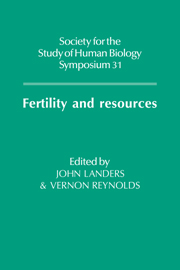Book contents
- Frontmatter
- Contents
- List of contributors
- 1 Introduction
- 2 Environmental and social determinants of fecundity in primates
- 3 Biological aspects of fertility among Third World populations
- 4 A preliminary report on fertility and socio-economic changes in two Papua New Guinea communities
- 5 The cultural context of fertility transition in immigrant Mennonites
- 6 Inter-relationships between consanguinity, religion and fertility in Karnataka, South India
- 7 Resources and the fertility transition in the countryside of England and Wales
- 8 Fertility decline and birth spacing among London Quakers
- 9 Population growth, innovation and resource exploitation
- 10 Fertility decline in developing countries: the roles of economic modernization, culture and Government interventions
- 11 Understanding recent fertility trends in the Third World
- 12 Monogamy, landed property and demographic regimes in pre-industrial Europe: regional contrasts and temporal stabilities
- Index
11 - Understanding recent fertility trends in the Third World
Published online by Cambridge University Press: 13 March 2010
- Frontmatter
- Contents
- List of contributors
- 1 Introduction
- 2 Environmental and social determinants of fecundity in primates
- 3 Biological aspects of fertility among Third World populations
- 4 A preliminary report on fertility and socio-economic changes in two Papua New Guinea communities
- 5 The cultural context of fertility transition in immigrant Mennonites
- 6 Inter-relationships between consanguinity, religion and fertility in Karnataka, South India
- 7 Resources and the fertility transition in the countryside of England and Wales
- 8 Fertility decline and birth spacing among London Quakers
- 9 Population growth, innovation and resource exploitation
- 10 Fertility decline in developing countries: the roles of economic modernization, culture and Government interventions
- 11 Understanding recent fertility trends in the Third World
- 12 Monogamy, landed property and demographic regimes in pre-industrial Europe: regional contrasts and temporal stabilities
- Index
Summary
Introduction
The full force of social controls on the speed of human reproduction can be clearly appreciated when we contrast reproductive potential with realized levels of fertility. Although the calculation of potential fertility, or fecundity, is beset with conceptual, technical and measurement problems, a consensus has emerged that for most human populations, the upper limit on the average number of live births per woman must lie between 13 and 17 (Bongaarts & Potter, 1983: p. 79). This is not to deny that some individual women can and do produce many more than this number, but for populations rather than individuals in which biology is the only factor restricting fertility, an acceptable average number of births per woman is around 15.3. Even this number of births can only be achieved by a rare combination of circumstances. We can list these very briefly:
– continuous exposure to the risk of conception between menopause and menarche, meaning a steady sexual relationship throughout the woman's fertile life;
– complete avoidance of any contraceptive method, including ‘natural’ methods, during the entire reproductive lifespan;
– no use of induced abortion or of any activity which might be undertaken to provoke a miscarriage;
– avoidance of any breastfeeding practice.
Clearly, this combination of conditions is very rare, helping to explain why measured levels of ‘natural’ marital fertility rarely surpass 11 or 12 live births. Some historical data based on written records or family reconstitution methods have thrown up a few populations in which most of the above conditions are met (see the summary table in Leridon, 1977: pp. 107–9).
- Type
- Chapter
- Information
- Fertility and Resources , pp. 146 - 163Publisher: Cambridge University PressPrint publication year: 1990
- 1
- Cited by



